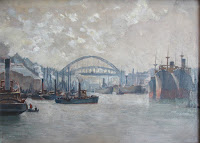Studio 7, The Ropewalk,
Barton upon Humber
Introduction
Last year I went to an exhibition of works by Richard Hatfield and Tim Needham at the Ropewalk, Barton upon Humber. I was interested in Richard's use of texture and his colour palette in his landscape paintings.
Richard Hatfield, Two small paintings Jetty (left) and Riverbed (right)
BORN: Boston, Lincolnshire,
1960
STUDIED: Grimsby School of
Art, West Surrey College of Art & Design (Farnham)
EXHIBITIONS : Include, Royal
Festival Hall, London Institute, Affordable
Art Fair, Battersea, Patriot Hall Gallery, Edinburgh, Ferens Art Gallery, Hull, North Lincolnshire
Museum and Art Gallery, Zillah Bell Contemporary Art, Thirsk, Usher Art
Gallery, Lincoln, and others across the
country.
Background Information
Extract from Richard’s Website:
“The colours, scale and nature of the landscape provide a
constant source for my image making. The paintings are the amalgamation of the
remembered, the fleetingly observed and the emblematic motifs imprinted on the
retina.
The paintings (using oil and acrylic) are constructed using
layer upon layer of thin colour that produce an intensity of pigment or create
ambiguous veils of paint that vaguely describe the subject. Often painted over
a coarse textured ground, layers of paint are added and subsequently removed
generating a rich patination of surface".
“He works paint into multi-layered and complex surfaces,
where, through repeated attention, seeks to reveal a critical moment of
harmony. This approach finds dramatic effect even in the smallest of works,
where, through mixing colour directly onto the painting, hues and tones emerge,
appearing to have almost seeped out of the environment and into the surface of
the painting.”
(Gill Hobson, artist and writer).
Richard’s Practice
Statement:
“My paintings are a reinterpretation of the landscape I see
every day, reflecting its scale and the colours of the changing seasons. I am
concerned with our growing alienation from nature and its disconnection from
our daily lives.” (Quote from Open Studios website)
Interview
In my Interview with Richard I asked him about his approach
and techniques to painting. I had seen a recent exhibition of Richard’s work
and already knew that he specialises in atmospheric landscapes, with an
emphasis on texture and colour to give the “feel’ of a place. I asked Richard
the techniques he uses when creating his landscape paintings.
Richard creates texture by painting over his old paintings,
this gives a “ready-made” texture to begin with. He puts a primer on first, and
it does not matter what direction it goes in. Then he textures the primer. He
makes an acrylic gesso mixed with whiting or acrylic binder. He just slaps it
on. Then he dry brushes it afterwards for effect as the acrylic is slightly
drying. Some bits come off, and some are smoother. He mixes his pigment
(acrylic) with binder or water and works in thin layers or thicker ones.
Richard works intuitively and has got into his own method of working. He goes
through this process and something comes out the other end. He does not usually
have a pre-conceived idea or picture in his head. He may have a thought of a
bit of light in a field and start a painting based on that. His paintings are
not representational, but are parallel to or equivalent of the subject matter –
feeling is more important.
Some examples of Richard’s paintings and his way of working
are shown below. Both works showcase Richard’s techniques, use of texture and
subtle use of colour using a reduced palette.
Richard Hatfield, Fading Light
Richard Hatfield, New River
Conclusions and summary
I think that the idea of using old canvasses and painting over them is an excellent idea. Not only does it provide ready-made texture, but is also environmentally friendly by recycling.
Also, I could adopt some of Richard's other methods to add texture, such as adding material to gesso, primer or paint. I have done some of this before , but I have not used whiting or binder for this purpose. His way of working in thin layers could also work for me.
I think that Richard's colour choice is good in that he works within a small range of hues which suit his subject matter. Although Richard's work is non-representational, I can pick up on some of his techniques to highlight areas of the canvas to emphasise a focal point - as he does in new River (above) where bright green/blue provides the focal interest.
I was interested in the fact that Richard's thinking behind his practice has much in common with my own, summed up as follows:
"I am concerned with our growing alienation from nature and its disconnection from our daily lives."
(Richard Hatfield)
(Richard Hatfield)


























































